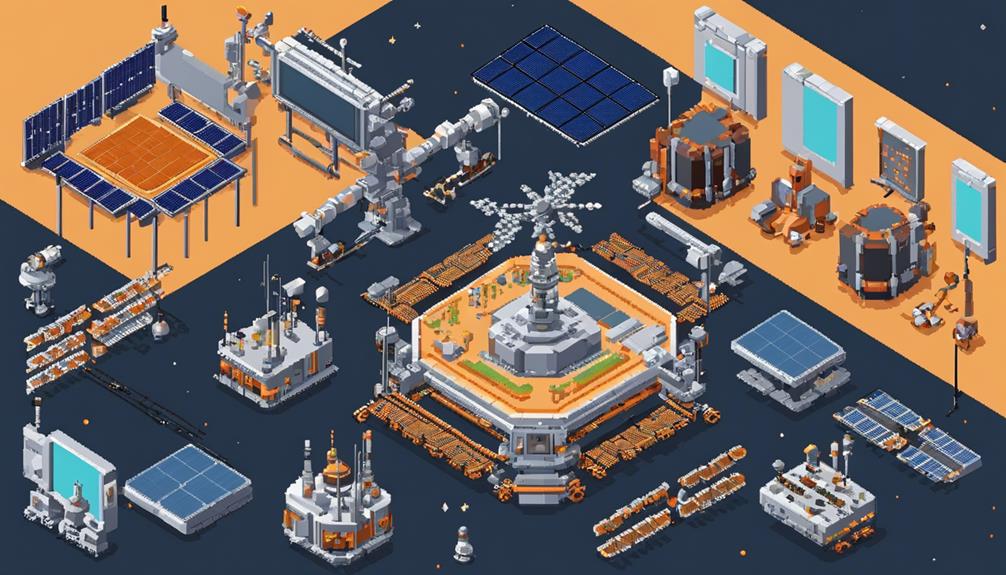The foundation of any satellite's operational success lies in its hardware components, intricately designed and strategically placed to ensure seamless functionality in the harsh environment of space. From the communication systems that establish vital links with Earth to the propulsion mechanisms that dictate orbital maneuvers, each piece plays a pivotal role in the satellite's mission. Delving into the complexities of satellite hardware components unveils a world where precision engineering meets the unforgiving vacuum of space, where every detail holds the key to unlocking the mysteries of the universe.
Key Takeaways
- Satellite bus integrates essential systems for satellite functionality.
- Power systems generate, store, and distribute power for satellite operations.
- Data handling and communication manage onboard functions and enable Earth communication.
- Payload integration enables diverse satellite functions in various fields.
Satellite Bus Overview
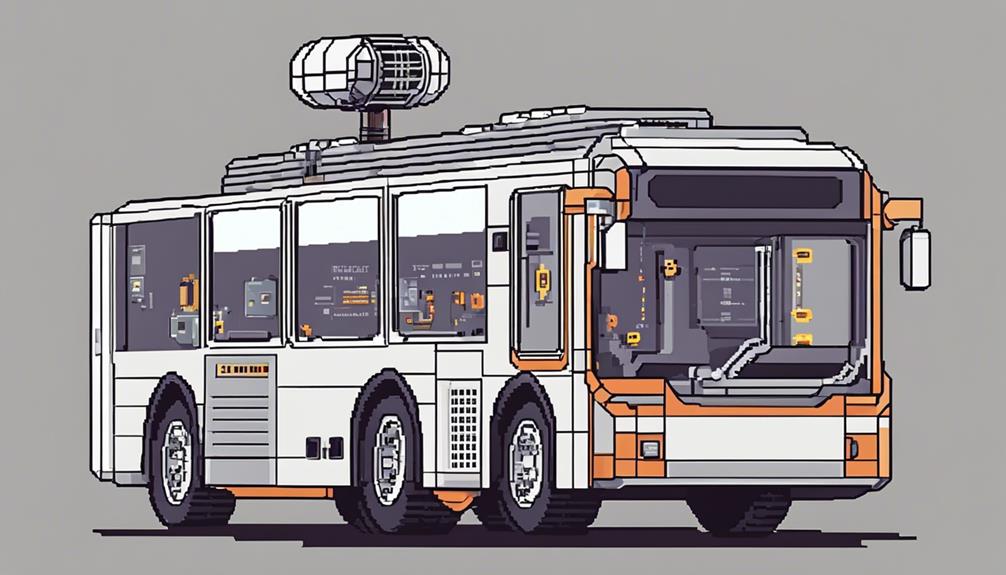
When considering the intricate architecture of a satellite, the satellite bus emerges as the foundational structure housing critical components essential for its operation. The satellite bus serves as the central hub that integrates various systems and components crucial for the satellite's functionality. Within the bus, essential systems such as power systems, communications systems, and propulsion systems are housed and interconnected to ensure seamless operation.
Power systems within the satellite bus are responsible for generating, storing, and distributing power to all satellite components. These systems utilize solar panels or other power sources to ensure a stable energy supply throughout the satellite's mission. Communications systems, another vital component of the bus, enable the satellite to transmit and receive data, commands, and other important information to and from the ground station or other satellites. These systems facilitate the exchange of information necessary for the satellite's operations and mission objectives.
Moreover, propulsion systems integrated into the satellite bus provide the necessary thrust for orbital maneuvers, attitude control, and station-keeping. By housing these components within the satellite bus, the structure not only provides physical support but also enables the seamless interaction and coordination of various systems to ensure the overall functionality of the satellite. The design and customization of the bus play a pivotal role in determining the satellite's capabilities and mission success.
Functions of the Satellite Bus
The functions of the satellite bus encompass a comprehensive array of critical roles in satellite operations. These include overseeing the bus architecture to ensure proper integration of subsystems, managing the power distribution system for efficient energy utilization, and handling data to facilitate communication between components. Understanding the intricacies of these functions is essential for optimizing satellite performance and ensuring successful mission outcomes.
Bus Architecture Overview
Within the design of a satellite, the bus architecture functions as the foundational framework that integrates and supports essential hardware components. The satellite bus serves as the structural backbone, providing mechanical support for crucial components such as the payload, power system, and propulsion system. It determines the satellite's overall size, shape, and weight distribution, optimizing its performance in orbit. Components like solar panels, antennas, and propulsion systems are typically mounted on the bus, showcasing its importance in the satellite's functionality and stability. Below is a table illustrating the key functions of the satellite bus architecture:
| Function | Description |
|---|---|
| Structural Support | Provides a framework for integrating and supporting essential satellite components. |
| Weight Distribution | Determines the distribution of weight across the satellite for optimal performance. |
| Component Integration | Allows for the mounting of various hardware components such as solar panels and antennas. |
Power Distribution System
Managing power generation, storage, and distribution within the satellite bus, the power distribution system ensures continuous and efficient power supply to all essential components for uninterrupted operation. Solar panels play a crucial role in this system by converting sunlight into electrical power. This power is stored in batteries to sustain operations during eclipse periods when the panels are not receiving sunlight. The power distribution system then routes the electrical power to various subsystems such as communication, propulsion, and thermal control. Efficient distribution is vital for maintaining the functionality of the satellite and ensuring the success of its mission. By effectively managing power resources, the power distribution system plays a critical role in the overall operation of the satellite.
Data Handling Functions
Data handling functions on the satellite bus encompass the critical processes of processing, storing, and transmitting data essential for satellite operations. The Command and Data Handling (C&DH) system is responsible for managing onboard functions such as telemetry, telecommand, and data processing. These systems ensure the proper execution of commands, data collection, and communication with ground stations, playing a vital role in controlling satellite functions and monitoring health status for mission success. Effective data handling is crucial for maintaining communication, navigation, and payload operations in space. Below is a table illustrating the key data handling functions on satellites:
| Data Handling Functions | Description |
|---|---|
| Telemetry | Data transmission to ground stations for monitoring satellite health and status. |
| Telecommand | Sending commands from ground stations to control satellite functions. |
| Data Processing | Handling, processing, and storing data onboard the satellite for various operations. |
| Communication | Ensuring proper communication links between the satellite and ground stations. |
Importance of Payload Systems
Payload systems on satellites play a pivotal role in enabling specific functions or missions by carrying essential equipment such as cameras, sensors, or transmitters. These systems are fundamental components of satellite hardware, contributing significantly to the operational success of various satellite missions. Some key points highlighting the importance of payload systems include:
- Facilitating Communication: Payload systems are integral for establishing communication links between the satellite and ground stations. They enable functions like transmitting data, enabling secure communication channels, and supporting activities such as telecommunication services.
- Enhancing Earth Observation: Through advanced sensors and cameras, payload systems enable satellites to capture high-resolution images of Earth's surface, facilitating applications in areas such as environmental monitoring, urban planning, and disaster management.
- Supporting Scientific Research: Payloads equipped with specialized instruments enable scientific research in space, gathering data on atmospheric conditions, climate patterns, and celestial phenomena to expand our understanding of the universe.
- Enabling GPS Navigation: Payload systems play a crucial role in providing accurate positioning and navigation services through GPS satellites, supporting activities such as mapping, surveying, and transportation logistics.
The continuous advancement of satellite payload technology enhances the capabilities and efficiency of satellite missions, underscoring the critical role of these systems in enabling a wide range of applications and services in space.
Types of Satellite Payloads
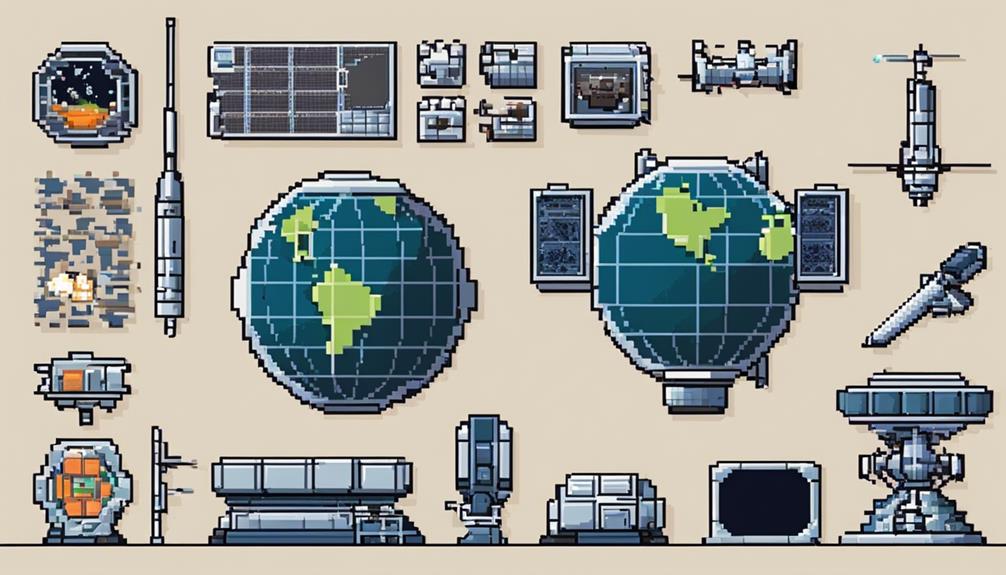
An essential component of satellite functionality is the diverse array of payloads designed to fulfill specific operational objectives and mission requirements. Satellites are equipped with various types of payloads, each serving a distinct purpose. The table below outlines some common types of satellite payloads along with their primary functions:
| Payload Type | Description | Applications |
|---|---|---|
| Communication | Enable signal relay between the satellite and Earth | Telecommunications, broadcasting |
| Remote Sensing | Capture data for applications like weather forecasting | Earth observation, agriculture |
| Navigation | Provide precise location information for GPS and tracking systems | Positioning, mapping |
These payloads play a crucial role in the overall functionality of satellites. Communication payloads facilitate the transmission of data between the satellite and ground stations, ensuring seamless connectivity. Remote sensing payloads capture valuable information used in various fields such as agriculture, environmental monitoring, and disaster management. Navigation payloads enhance the accuracy of positioning systems, benefiting applications like navigation services and tracking technologies. The integration of these diverse payloads enables satellites to perform a wide range of tasks, from scientific research missions to defense applications like surveillance and reconnaissance.
Integration of Hardware Components
The integration of hardware components in satellites is a meticulous process that involves combining antennas, power systems, propulsion systems, and guidance sensors into a cohesive unit to ensure optimal functionality and mission success. This integration process is crucial for the seamless operation of satellite communications and electronic systems in space. Here are some key aspects of the integration of hardware components:
- Interconnection: Hardware components need to be interconnected effectively to facilitate data exchange and power distribution within the satellite system.
- Compatibility Testing: Before launch, thorough testing is conducted to ensure that all hardware components are compatible with each other and can function together efficiently.
- Calibration: Calibration of hardware components such as antennas and sensors is essential to maintain accuracy in satellite positioning and data collection.
- Verification: Verification processes are employed to confirm that the integrated hardware components meet the required performance standards for successful satellite operations.
Role of Attitude Control Systems
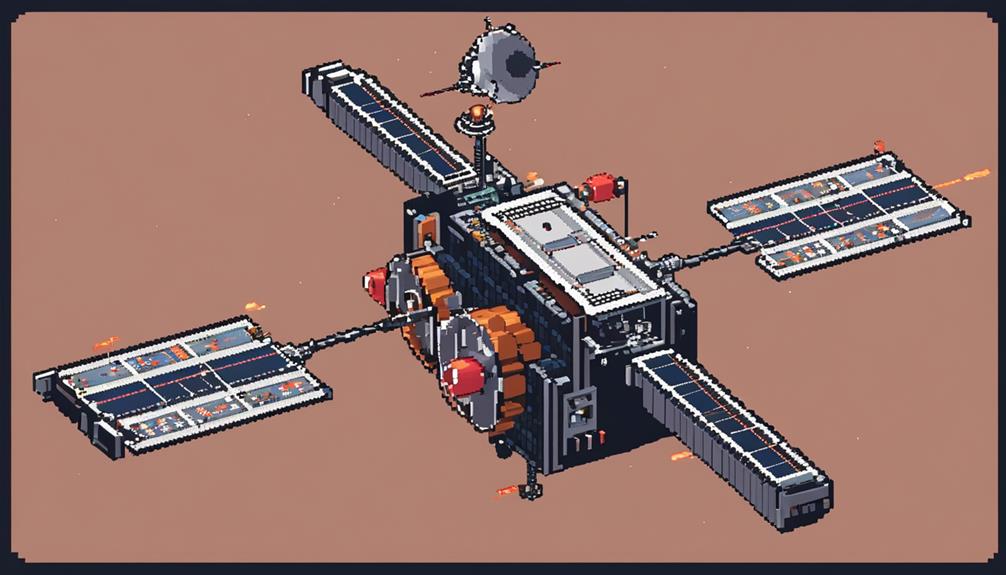
Attitude control systems play a critical role in maintaining a satellite's precise orientation in space. By utilizing sophisticated control mechanisms, these systems ensure stability and facilitate adjustments to the satellite's orientation as needed. The precise orientation adjustments carried out by attitude control systems are essential for optimizing the satellite's functionality, whether it be for communication purposes or observational tasks.
Control Mechanisms
Control mechanisms, integral components of satellite hardware, play a crucial role in maintaining proper orientation and stability in space.
- Attitude control systems on satellites use sensors like gyroscopes and star trackers to determine satellite position.
- Actuators such as reaction wheels or thrusters adjust the satellite's orientation as needed.
- These systems ensure antennas and solar panels are directed correctly for optimal performance.
- Attitude control systems are essential for satellite functions like communication, imaging, and data collection.
Stability Maintenance
Efficient stability maintenance in satellite operations relies heavily on the seamless coordination of sophisticated sensors and actuators. Attitude control systems play a fundamental role in managing a satellite's orientation and stability in space. These systems utilize sensors to gather information about the satellite's position and actuators to make necessary adjustments. Proper alignment achieved through attitude control is essential for enabling smooth communication, optimal exposure of solar panels to sunlight for power generation, and correct operation of onboard instruments. Without precise attitude control, satellites risk facing communication disruptions and reduced power generation capabilities. Ensuring the functionality and success of a satellite mission hinges on the effectiveness of its attitude control systems and the accuracy of the data provided by the sensors.
| Attitude Control Systems | Sensors |
|---|---|
| Manage satellite orientation | Gather position data |
| Ensure stability in space | Provide information for adjustments |
| Essential for proper alignment | Enable optimal satellite performance |
Orientation Adjustment
Effective satellite operations hinge on the precise adjustment of orientation in orbit, a critical function facilitated by the sophisticated role of attitude control systems. Attitude control systems play a vital role in ensuring that satellites are properly positioned in orbit by adjusting their orientation. Here are key points regarding the role of attitude control systems in satellite operations:
- Attitude control systems adjust the satellites' position for optimal performance.
- These systems utilize sensors, actuators, and control algorithms to maintain stability.
- Proper alignment by attitude control systems ensures efficient pointing of communication beams and sensors.
- Satellite attitude control systems contribute significantly to the overall efficiency of satellite operations and data collection.
Power Generation and Distribution
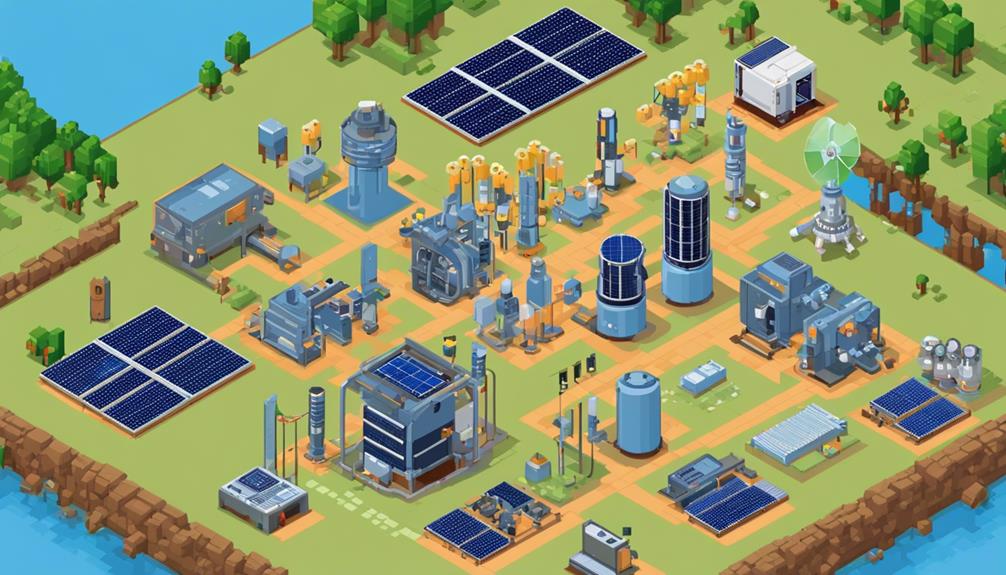
Solar panels are a widely utilized means of generating electricity on satellites by converting sunlight into electrical power. These solar panels are crucial for providing the necessary energy to power the various systems onboard. Excess energy generated by the solar panels is stored in batteries to ensure a continuous power supply when the satellite is not in direct sunlight.
Efficient power distribution systems are integral to satellites to ensure that electricity is distributed evenly and reliably to all components. Redundant power systems are often implemented to guarantee continuous operation even if a component fails. These redundant systems help maintain the functionality of the satellite and ensure that critical onboard equipment continues to operate seamlessly.
Power generation and distribution systems play a vital role in the overall functionality of satellites. Without these systems, satellites would not be able to power the numerous components essential for their operation. Therefore, ensuring the efficiency and reliability of power systems is paramount in satellite design and maintenance to guarantee the success of satellite missions.
Communication Systems Overview
Power generation and distribution systems are fundamental components of satellites, supporting various onboard operations, including communication systems that encompass antennas and transponders for signal transmission. Satellite communication systems are pivotal for enabling two-way communication with Earth and play a crucial role in maintaining connectivity for various applications. The antennas on satellites are essential components responsible for accurately receiving and transmitting signals to establish communication links. Additionally, transponders within satellites are instrumental in converting signals between different frequencies, ensuring compatibility and efficient signal transmission.
- Satellite communication systems consist of antennas and transponders for signal transmission.
- Communications systems in satellites enable two-way communication with Earth.
- Transponders in satellites convert signals between different frequencies.
- Antennas on satellites are crucial for receiving and transmitting signals accurately.
These components work together seamlessly to facilitate effective communication between satellites and ground stations, enabling a wide range of services such as telecommunication, weather monitoring, navigation, and remote sensing. The intricate design and precise functionality of communication systems in satellites demonstrate the technological advancements that have revolutionized modern communication capabilities.
Thermal Control Mechanisms
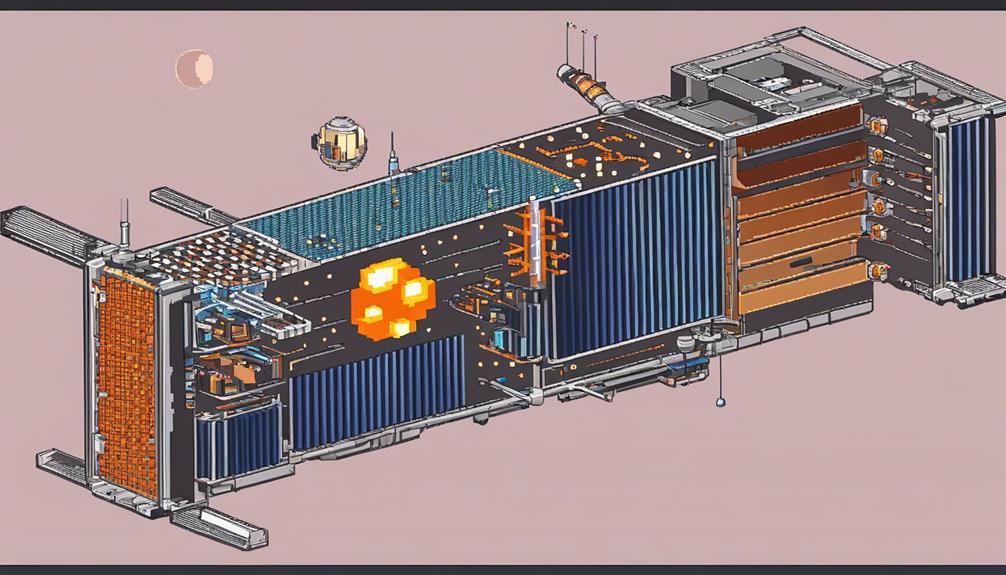
Thermal control mechanisms implemented on satellites are crucial for safeguarding onboard components against the extreme temperature conditions prevalent in outer space. These mechanisms play a vital role in maintaining the operational efficiency and longevity of sensitive satellite components. Various techniques are employed to manage thermal conditions within a satellite. Below is a table outlining some key thermal control mechanisms used in satellite hardware:
| Thermal Control Mechanisms | Description |
|---|---|
| Insulation | Prevents heat transfer between internal and external environments. |
| Radiators | Emit excess heat generated by the satellite into space. |
| Heat Pipes | Efficiently transfer heat from one point to another within the satellite. |
| Heat Shields | Protect sensitive components from extreme temperatures and solar radiation. |
These mechanisms work in tandem to ensure that the internal temperature of the satellite remains within the optimal range for the proper functioning of sensitive components. Additionally, temperature sensors and controllers are employed to monitor and regulate the thermal environment inside the satellite. By effectively managing heat dissipation and insulation, satellite thermal control mechanisms contribute significantly to the overall performance and reliability of satellite systems.
Propulsion Systems in Satellites
Satellite propulsion systems play a critical role in facilitating orbit positioning and station keeping, essential for the satellite's operational functions in space.
- Propulsion systems in satellites are crucial for maintaining the satellite's intended orbit and ensuring it stays within its designated position.
- Satellites utilize rockets as the primary means of propulsion to make adjustments to their orbits and effectively hold their positions in space.
- The type of propulsion system equipped on a satellite significantly influences its maneuverability and ability to navigate through space with precision.
- Thrusters are integral components of the propulsion system, responsible for managing the satellite's attitude and controlling its trajectory.
The efficiency and effectiveness of the propulsion system are paramount factors that directly impact the satellite's operational capabilities and lifespan. By utilizing the propulsion system for orbit adjustments and station keeping, satellites can fulfill their intended functions effectively and remain operational for extended periods. The choice of fuel type, the design of the propulsion system, and the overall efficiency of the system are all critical considerations in ensuring the satellite can maintain its position and perform its tasks with accuracy.
Safety and Redundancy Measures
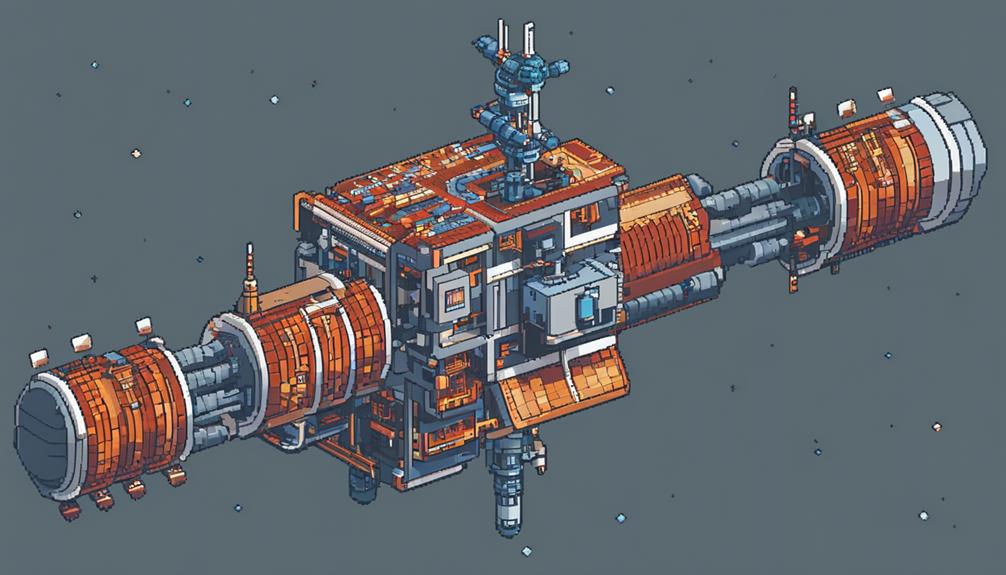
In the realm of satellite hardware, the meticulous integration of safety and redundancy measures stands as a cornerstone for ensuring mission success and longevity in the face of potential challenges. Redundancy measures play a crucial role in satellite hardware, providing backup systems for critical components such as power and communication. These redundant systems ensure continuous functionality even in the event of system failures or external threats, safeguarding the satellite's operation. Safety features are equally important, with protocols in place to protect satellite components from extreme temperature fluctuations and other hazards that could arise during the mission. For instance, thermal control systems are designed to maintain the optimal temperature range for components to prevent damage from extreme changes in heat levels. Redundant power sources, including batteries and solar panels, further enhance the reliability of satellites by ensuring continuous power supply even in challenging conditions. Moreover, redundant communication systems guarantee uninterrupted data transmission, enabling satellites to stay connected with the ground station regardless of external factors.
| Safety and Redundancy Measures | ||
|---|---|---|
| Redundancy Measures | Safety Features | Examples |
| Backup systems for critical components | Thermal control systems | Redundant power sources |
| Redundant communication systems | Protection from extreme changes | Continuous data transmission |
| System backups for power and communication | Hazard mitigation protocols | Thermal control systems |
Frequently Asked Questions
What Are the Parts Needed to Build a Satellite?
To build a satellite, essential components include satellite power systems for energy generation, satellite structure for housing internal components, satellite propulsion for orbit control, and satellite payload for carrying mission-specific instruments. These parts collectively enable the satellite to function effectively in space. Each component plays a crucial role in ensuring the satellite's operational success and longevity.
What Are the Elements of Satellite Communication Systems?
In the realm of satellite communication systems, critical elements include frequency bands for optimal signal strength, antenna design for efficient signal reception, and power consumption for sustained functionality. These components play a vital role in ensuring reliable and effective communication between satellites and ground stations. By focusing on these key aspects, satellite communication systems can achieve enhanced performance and seamless data transmission capabilities.
What Is the Overview of Satellite Communications?
Satellite communications encompass a vast array of technology advancements and future innovations. Key components include satellite ground station networks that provide global coverage for seamless connectivity. These systems enable data exchange, broadcasting, and telecommunication services across the globe. As satellite technology continues to evolve, we can expect enhanced capabilities, increased efficiency, and broader applications in various industries. The integration of advanced ground networks will further optimize satellite communications for diverse needs.
What Are the Components of Rockets and Satellites?
Rocket engines are crucial components in launching satellites into orbit, providing the necessary thrust for ascent. The payload design encompasses various satellite hardware components, including antennas, solar panels, power systems, thermal regulation mechanisms, and tracking telemetry systems. These components work in unison to ensure the successful deployment and operation of satellites in space. Each element plays a vital role in the functionality and longevity of the satellite mission, underscoring the complexity of modern space technology.
